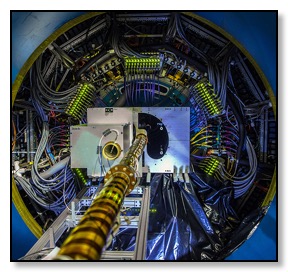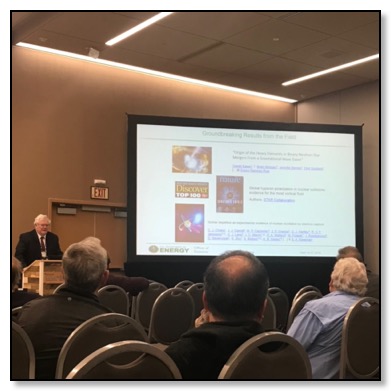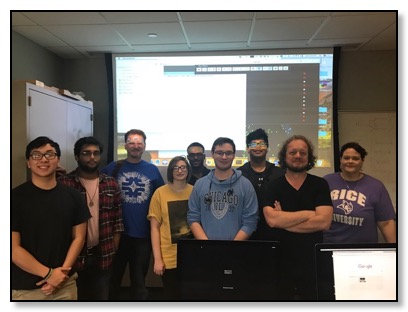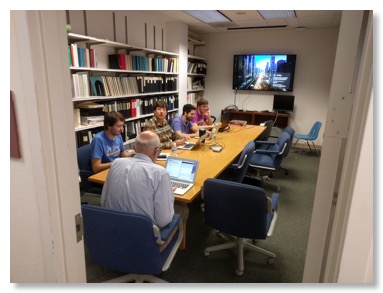STAR eTOF installation nears completion
November 22, 2018
With the installation of the lower 6 sectors, the endcap Time-of-Flight (eTOF) detector, a joint CBM/STAR project, has been fully installed as of Wednesday Nov.21. With the gas, high voltage, low voltage, clock and DAQ connections all in place the next step will follow in the commissioning efforts towards STAR's Beam Energy Scan Phase 2 which is scheduled to start late February/early March. Geary Eppley of Rice together with collaboration members from Heidelberg and with the excellent support from STAR's Technical Support Group have been working in the past couple of weeks getting the 36 modules -all shipped from Heidelberg, Germany- mounted to the endcap.
DOE Office of Science Highlight: Heavy Particles Get Caught Up in the Flow
September 07, 2018
Today, the DOE's Office of Science highlighted STAR's heavy-flavor program on its "Science Highlights" web page. Take a look at the following direct link to the release: Heavy Particles Get Caught Up in the Flow

The STAR Heavy Flavor Tracker, located in the center of STAR at the Relativistic Heavy Ion Collider at BNL.
Image courtesy of Brookhaven National Laboratory.

The STAR Heavy Flavor Tracker, located in the center of STAR at the Relativistic Heavy Ion Collider at BNL.
Image courtesy of Brookhaven National Laboratory.
2018 APS April Meeting
May 08, 2018
This year's APS April Meeting took place in ... April (not always a given) and was my first opportunity to visit the city of Columbus OH. Julia Velkovska (Vanderbilt) and Romana Vogt (LBL) organized a couple of topical workshops on heavy ion physics. One workshop discussed "High Baryon
Density Physics in Nuclei and the Cosmos". I was invited to talk what we can learn about high baryon density QCD from low energy nuclear collisions. Other talks in this (obviously very interesting!) session looked on the one hand at the nuclear equation of state from cosmological measurements such as gravitational waves from neutron star-black holes and binary neutron star mergers, while at the other hand looked at high
baryon density QCD from lattice calculations.

On the third day of the conference, the DNP section met and the nuclear physics leadership of the DOE Office of Science and NSF brought all up to speed on the current funding challenges and opportunities. Tim Hallman (Associate Director of the DOE Office of Science for Nuclear Physics, and former STAR spokesperson) highlighted a couple of times STAR in this presentation. Very nice!
Density Physics in Nuclei and the Cosmos". I was invited to talk what we can learn about high baryon density QCD from low energy nuclear collisions. Other talks in this (obviously very interesting!) session looked on the one hand at the nuclear equation of state from cosmological measurements such as gravitational waves from neutron star-black holes and binary neutron star mergers, while at the other hand looked at high
baryon density QCD from lattice calculations.

On the third day of the conference, the DNP section met and the nuclear physics leadership of the DOE Office of Science and NSF brought all up to speed on the current funding challenges and opportunities. Tim Hallman (Associate Director of the DOE Office of Science for Nuclear Physics, and former STAR spokesperson) highlighted a couple of times STAR in this presentation. Very nice!
QuarkNet Masterclass
March 26, 2018
On Saturday we organized the first QuarkNet Masterclass for high school students on the campus of Rice University. Several students and teachers attended a physics-filled day with lectures, demos, in-class activities, and hands-on analysis of data from the CMS experiment. We concluded the masterclass with a videoconference with a few other QuarkNet centra to discuss our work and answer any questions from the organizers or other students.
One of the teachers, Alain Harvey, shared a wonderful story on his Facebook feed about this which he kindly allowed me to share. I look forward to seeing more teachers and there students join in future returns of his great initiative. Of course, I should thank Umbe Oliveira-Cantu and the department for providing us all with lunch!

In Alain Harvey's words:
"Once a year, high school classes from around the world can participate in QuarkNet masterclasses.
These students spent an entire day on the Rice University campus, visiting the physics laboratories, and hearing faculty member Dr. Frank Geurts discuss his current research and the field of particle physics. The capstone activity was the analysis of real high energy physics data, and the exchange and comparison of the results with the other classes around the world via video-conference. As a result, students gained valuable insights relating to the topics and methodology of particle physics.
During the day students:
• Attended lectures on the Standard Model and learned how to analyze events;
• Analyzed events from various CERN or Fermilab particle physics experiments; and,
• Discussed their results with other student teams via international videoconferencing moderated by physicists.
MasterClass is a means for Quarknet high school teachers to share their enthusiasm for cutting edge science research and expertise with their own students. Rice University’s Physics and Astronomy Department generously hosted teacher-led teams for an entire day of engaging activities. Students examined actual CMS image data focused on Z- and W-bosons measurements, firsthand. Students also engaged with researchers and staff, toured available labs and meet others with similar interests from around the world!
During the morning session, students learned about the components of a particle accelerator and how to pick out identifying characteristics of particles from event data. This was a great opportunity for students to learn about cutting edge research and engage with physicists doing it!
The Physics Lab was followed by a leisurely lunch generously provided by Rice University.
The afternoon session culminated with teachers and their students participating in a live video conference with high school students and researchers from other QuarkNet centers located in the U.S. and other countries.
The QuarkNet Masterclass Program
QuarkNet is a long-term, research-based program in the United States jointly funded by the National Science Foundation and the U.S. Department of Energy.
Since 1999, QuarkNet has established centers at universities and national laboratories conducting research in particle physics (also called high-energy physics) across the United States.
Mentor physicists and physics teachers collaborate to bring cutting-edge physics to high school classrooms. QuarkNet offers research experiences for teachers and students, teacher workshops and sustained follow-on support.
Through these activities, teachers enhance their knowledge and understanding of scientific research and transfer this experience to their classrooms, engaging students in both the substance and processes of contemporary physics research.
In 2007, QuarkNet first piloted U.S. Masterclasses, modeled on a program offered by EPPOG and studying Large Electron-Positron Collider-era CERN data. Today masterclasses study ALICE, ATLAS or CMS data. Masterclasses are one-day national events in which teams of students visit a nearby university or research center to gain insight into topics and methods of particle physics.
2011 was the first year that LHC data were incorporated into the masterclass There were exercises for ATLAS (Z- and W-bosons measurements), ALICE (for stranger particles), and CMS (J/ψ meson).
2012 saw the incorporation of expanded CMS data (W/Z measurement.)
Quarknet MasterClasses are held annually in February or March, and are open to high school teachers participating the QuarkNet program, just one of the perks for the joint Quarknet Summer Institute at Rice University and the University of Houston!
What my students had to say:
"Not only did the MasterClass introduce me to an exciting new college scene, but it also introduced me to intelligent people, who have a desire to participate in activities concerning particle physics as I do. It was informative; and even exciting; how we spoke about what we were going to look at and determine through observing electronic diagrams.
We looked at various similar yet classifiably different diagrams and determined what exactly they were using only a set of notes we established earlier and our wit! It was awe-inducing to work and compare results with other students my age on the same project, from across the country and the world. As a junior in high school, I have considered taking general physics in college, and this course gave me some experience that will help me decide how to consolidate on what kind of physics I would like to accomplish working with. I will recall this experience for years to come, and look forward to more like this one."
Harris Khan, Jersey Village High School, Houston, Texas
"One of the most memorable things of the project was how when we had conflicting data (such as two muons and one electron) and no one would know what to classify the collision as being. This showed me how even today physicists are still seeking answers to events at subatomic size. I gained a lot from the Quarknet MasterClass, and I hope I can do more things like it next year."
Anthony Luu, Cypress-Woods High School, Houston, Texas"
One of the teachers, Alain Harvey, shared a wonderful story on his Facebook feed about this which he kindly allowed me to share. I look forward to seeing more teachers and there students join in future returns of his great initiative. Of course, I should thank Umbe Oliveira-Cantu and the department for providing us all with lunch!

In Alain Harvey's words:
"Once a year, high school classes from around the world can participate in QuarkNet masterclasses.
These students spent an entire day on the Rice University campus, visiting the physics laboratories, and hearing faculty member Dr. Frank Geurts discuss his current research and the field of particle physics. The capstone activity was the analysis of real high energy physics data, and the exchange and comparison of the results with the other classes around the world via video-conference. As a result, students gained valuable insights relating to the topics and methodology of particle physics.
During the day students:
• Attended lectures on the Standard Model and learned how to analyze events;
• Analyzed events from various CERN or Fermilab particle physics experiments; and,
• Discussed their results with other student teams via international videoconferencing moderated by physicists.
MasterClass is a means for Quarknet high school teachers to share their enthusiasm for cutting edge science research and expertise with their own students. Rice University’s Physics and Astronomy Department generously hosted teacher-led teams for an entire day of engaging activities. Students examined actual CMS image data focused on Z- and W-bosons measurements, firsthand. Students also engaged with researchers and staff, toured available labs and meet others with similar interests from around the world!
During the morning session, students learned about the components of a particle accelerator and how to pick out identifying characteristics of particles from event data. This was a great opportunity for students to learn about cutting edge research and engage with physicists doing it!
The Physics Lab was followed by a leisurely lunch generously provided by Rice University.
The afternoon session culminated with teachers and their students participating in a live video conference with high school students and researchers from other QuarkNet centers located in the U.S. and other countries.
The QuarkNet Masterclass Program
QuarkNet is a long-term, research-based program in the United States jointly funded by the National Science Foundation and the U.S. Department of Energy.
Since 1999, QuarkNet has established centers at universities and national laboratories conducting research in particle physics (also called high-energy physics) across the United States.
Mentor physicists and physics teachers collaborate to bring cutting-edge physics to high school classrooms. QuarkNet offers research experiences for teachers and students, teacher workshops and sustained follow-on support.
Through these activities, teachers enhance their knowledge and understanding of scientific research and transfer this experience to their classrooms, engaging students in both the substance and processes of contemporary physics research.
In 2007, QuarkNet first piloted U.S. Masterclasses, modeled on a program offered by EPPOG and studying Large Electron-Positron Collider-era CERN data. Today masterclasses study ALICE, ATLAS or CMS data. Masterclasses are one-day national events in which teams of students visit a nearby university or research center to gain insight into topics and methods of particle physics.
2011 was the first year that LHC data were incorporated into the masterclass There were exercises for ATLAS (Z- and W-bosons measurements), ALICE (for stranger particles), and CMS (J/ψ meson).
2012 saw the incorporation of expanded CMS data (W/Z measurement.)
Quarknet MasterClasses are held annually in February or March, and are open to high school teachers participating the QuarkNet program, just one of the perks for the joint Quarknet Summer Institute at Rice University and the University of Houston!
What my students had to say:
"Not only did the MasterClass introduce me to an exciting new college scene, but it also introduced me to intelligent people, who have a desire to participate in activities concerning particle physics as I do. It was informative; and even exciting; how we spoke about what we were going to look at and determine through observing electronic diagrams.
We looked at various similar yet classifiably different diagrams and determined what exactly they were using only a set of notes we established earlier and our wit! It was awe-inducing to work and compare results with other students my age on the same project, from across the country and the world. As a junior in high school, I have considered taking general physics in college, and this course gave me some experience that will help me decide how to consolidate on what kind of physics I would like to accomplish working with. I will recall this experience for years to come, and look forward to more like this one."
Harris Khan, Jersey Village High School, Houston, Texas
"One of the most memorable things of the project was how when we had conflicting data (such as two muons and one electron) and no one would know what to classify the collision as being. This showed me how even today physicists are still seeking answers to events at subatomic size. I gained a lot from the Quarknet MasterClass, and I hope I can do more things like it next year."
Anthony Luu, Cypress-Woods High School, Houston, Texas"
Ruthenium & Zirconium
March 13, 2018
IT IS ON!!! After a couple of weeks of taking data from cosmic rays crossing through the STAR detectors, we have now officially changed to "Physics Mode" and are back again taking collider data from heavy-ion collisions. But, this year is special. This year we are looking at collisions between ruthenium (Ru-96) and Zirconium (Zr-96). As you can tell both isotopes carry the same total number of nuclei (protons + neutrons). The difference is in how the atomic mass is distributed between the protons and neutrons. Zirconium has an atomic number (read: number of protons) of Z=40, while Ruthenium has Z=44.
The physics motivation for running these two species lies in the subtle but significant difference in that number and the effect that it may have on the very strong magnetic fields that develop in the initial stages of a collisions. Recall that these highly electrically charged heavy ions speed with ultrarelativistic velocities thus generating a very strong electrical current and magnetic field perpendicular to the collision plane. See this nice figure taken from a recent comment in Nature
The magnetic field is expected to have a subtle but measurable effect on the behavior of fundamental particles that created in the hot and dense quark-gluon plasma. The effect, called the Chiral Magnetic Effect, is different from what one would expect under "normal" conditions and tied to fundamental symmetries in nature. Testing the strength of this effect for different magnetic fields while keeping all other conditions more or less similar is one of the main drivers of this year's run period.
A nice write-up can be found at Brookhaven National Lab's website at this link.
The Rice group is working hard on making sure that the main working horses, the BTOF and VPD detectors as well as the MTD detector are fully functional and take high-quality data. At the same time, we work on testing a first sector of the endcap Time-of-Flight detector commissioned in anticipation of next year's continuation of the Beam Energy Scan program.
The physics motivation for running these two species lies in the subtle but significant difference in that number and the effect that it may have on the very strong magnetic fields that develop in the initial stages of a collisions. Recall that these highly electrically charged heavy ions speed with ultrarelativistic velocities thus generating a very strong electrical current and magnetic field perpendicular to the collision plane. See this nice figure taken from a recent comment in Nature

The magnetic field is expected to have a subtle but measurable effect on the behavior of fundamental particles that created in the hot and dense quark-gluon plasma. The effect, called the Chiral Magnetic Effect, is different from what one would expect under "normal" conditions and tied to fundamental symmetries in nature. Testing the strength of this effect for different magnetic fields while keeping all other conditions more or less similar is one of the main drivers of this year's run period.
A nice write-up can be found at Brookhaven National Lab's website at this link.
The Rice group is working hard on making sure that the main working horses, the BTOF and VPD detectors as well as the MTD detector are fully functional and take high-quality data. At the same time, we work on testing a first sector of the endcap Time-of-Flight detector commissioned in anticipation of next year's continuation of the Beam Energy Scan program.
STAR eTOF Software Workshop at Rice
February 25, 2018
The endcap Time-of-Flight detector is a detector upgrade for the STAR experiment that will improve particle identification capabilities significantly in the more forward region of its rapidity coverage. It will be an essential component that will take advantage of the other important upgrade, i.e. replacement of the inner sectors of STAR's decades old workhorse, the TPC. The second phase of the Beam Energy Scan is scheduled to take place in 2019-2020. The iTPC and eTOF upgrades will need to be installed and ready to go before that time. As the hardware installation and commissioning efforts are all well under way, it is important that the software developments ramp up and all be ready to analyze the data that we register, even if only from the first few modules that are installed for the 2018 run.
In the week of February 19, a group of students from Rice, Heidelberg, Darmstadt, and UC Davis met to discuss what is needed and how to seed the various development tasks that lie ahead. In the picture, below, you see Geary Eppley (with his back towards the camera), and from left to right Florian Seck (UT Darmstadt), David Tlusty (Rice), Daniel Brandenburg (Rice), and Philipp Weidenkaff (Heidelberg) in a small windowless conference room ...

Picture courtesy of Joey Butterworth.
In the week of February 19, a group of students from Rice, Heidelberg, Darmstadt, and UC Davis met to discuss what is needed and how to seed the various development tasks that lie ahead. In the picture, below, you see Geary Eppley (with his back towards the camera), and from left to right Florian Seck (UT Darmstadt), David Tlusty (Rice), Daniel Brandenburg (Rice), and Philipp Weidenkaff (Heidelberg) in a small windowless conference room ...

Picture courtesy of Joey Butterworth.
